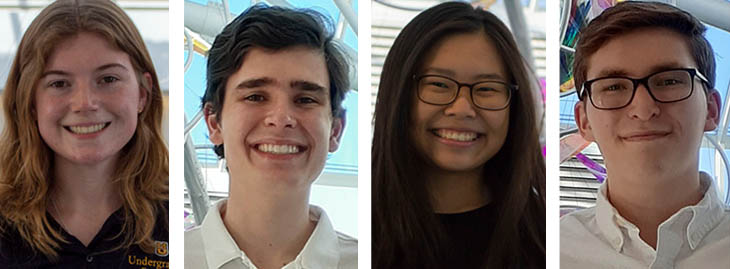April 14, 2021

Molly Harrison, J.D. Peiffer, Rebecca Shyu and Landon Swartz.
Four Mizzou Engineers were among 14 MU students selected to present their work during the UM System’s Undergraduate Research Day.
This year’s virtual, week-long celebration gave elected officials an opportunity to hear firsthand about the innovation and transformation taking place on campus.
Molly Harrison, a senior in chemical engineering, showcased her research into developing artificial implants for better bone tissue regeneration. Senor J.D. Peiffer, who is majoring in biomedical engineering, outlined a new method to measure lung function. Junior Rebecca Shyu, a computer science major, presented work she’s done with the Show-Me ECHO project. And Landon Swartz, a junior in computer engineering, showed off a device he developed to help scientists study the characteristics of plants.
Molly Harrison
Harrison, from Kirkwood, Missouri, works in a biomedical materials engineering lab under Professor Bret Ulery. The team is looking into a process that uses hydrogen peroxide to stimulate cell growth. This could lead to a new biomaterial that could help bones regenerate on their own.
“My experience doing undergraduate research at Mizzou has been amazing and has impacted me in many ways,” she said during the presentation. “It has opened up a lot of very neat opportunities.”
Harrison has presented at a national conference and was a Cherng Summer Scholar through the Honors College. This summer, she plans to do research at the Wake Forest Institute for Regenerative Medicine in Winston-Salem, North Carolina.
J.D. Peiffer
Peiffer, from Ballwin, Missouri, is working with doctors in the Department of Radiology at the MU School of Medicine. Specifically, he and the team are comparing the new method, called Xenon, to traditional techniques, which use radiation.
Through the Xenon process, patients inhale a safer gas using an MRI machine without radiation. The procedure was tested on both healthy lungs and the lungs of patients with COPD. In most cases, the Xenon process performed better than traditional nuclear medicine.
MU is one of just a handful of universities that can perform this type of imaging, he said.
“I truly enjoy performing research that nobody else has done before,” he said. “And this process has taught me much about solving new problems. It also showed me that there are many ways for science and research to benefit the health of the public.”
Peiffer is now choosing which graduate school to attend and plans to continue research.
Rebecca Shyu
Shyu, from Columbia, has been working with Show-Me ECHO since 2018. Show-Me ECHO (Extension for Community Healthcare Outcomes) uses videoconferencing to connect experts with primary care providers and other professionals in rural communities. The idea is to move knowledge and information without having to move patients.
“The research question is, what is the impact on rural patients’ access to health care when more providers participate in Show-Me Echo training to learn about chronic conditions?” Shyu said. “By providing quality health care in rural communities, time, money and lives are being saved.”
Shyu, a recent Goldwater Scholarship winner, will intern with Harvard Medical School this summer. After graduation, she plans to pursue a PhD in biomedical informatics.
“Overall, I’ve loved my undergraduate research experience,” she said during her presentation. “I’ve had so many incredible opportunities and have met talented peers and mentors. I will take that with me for the rest of my life.”
Landon Swartz
Swartz, from Springfield, Missouri, works with plant scientists in the Bond Life Sciences Center.
There, he and the research team are focused on solving the problem of future food security.
One way to ensure enough food for a growing population would be to reform current crops to be more nutritious, have higher yields and to be more resilient. To do that, scientists will need to better understand the physical characteristics of individual plants over time.
Swartz designed a “single row phenotyper” (SRP) to collect information about the characteristics of individual plants. The device uses a camera carried on an aluminum beam to capture more than 1,000 high-resolution images of plants over their lifetime.
“Throughout this entire process, I have gained a deep appreciation for interdisciplinary collaboration to solve large-scale problems,” he said. “And because of my experiences at the University of Missouri, I plan to attend graduate school to research engineering solutions to biological problems.”